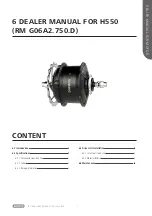
Chapter II Technical Information of Engine
Great Wall Baoding Internal Combustion Engine
Manufacturing Company Limited
53
Fig. 2-10-5 Understanding the structure of
the diesel engine
Fig. 2-10-6 Using special tools
Fig. 2-10-7 Marking the parts with positional,
optional, directional and matching
requirements
1.13 The moving parts should be flexible without seizure
and bumping.
1.14 The spare parts should be handled gently during
assembling; bumping and scratching are not allowed.
For the electric control sensor, actuator and fuel injector,
dropping, pressing and wetting are not allowed.
2. General Technical Requirements for
Removal
2.1 The removal is the first step for the repair work. The
purpose is to check and repair damaged parts.
First, make clear the structures and characteristics of
GW4D20
/
GW4D20B turbocharged diesel engines, and
make clear the removing procedure and method to avoid
damage of spare parts. See Fig. 2-10-5.
2.2 The removal should be carried out in a proper
sequence. Generally, the rules for removal include from
the complete machine to assemblies, from assemblies to
components,
from
components
to
parts,
from
accessories to main parts and from exterior to interior.
―Caution‖: In order to remove correctly and
efficiently, it is necessary to make clear the structure of
the GW4D20
/
GW4D20B turbocharged diesel engine
first.
2.3 For the parts whose technical conditions are normal
and can be judged without removal, it is unnecessary to
remove them. But for the parts whose technical
conditions are hard to define without removal, it is
necessary to remove them for further examination and
repair.
2.4 Appropriate tools should be selected when the parts
are removed in accordance with their structures. Fierce
knock is not allowed to avoid damage and deformation of
the parts. In order to improve efficiency, use special
tools. See Fig. 2-10-6. When the bolts and nuts are
removed, the proper sized fixed spanner should be
selected, it is not recommended to use the adjustable
spanner or randomly extend the torque for the spanner.
2.5 For the parts which have positional, optional and
directional requirements such as main shaft bearing
shells, valves, pistons and connecting rods, etc., in order
to improve the assembling efficiency and ensure correct
assembling, they should be marked on the non-working
face in accordance with specific conditions.
2.6 The parts removed should not be left about or piled
up, they should be classified and stored in accordance
with their materials, sizes, shapes and precisions so as
to avoid damage or missing and facilitate the next
process.
















































